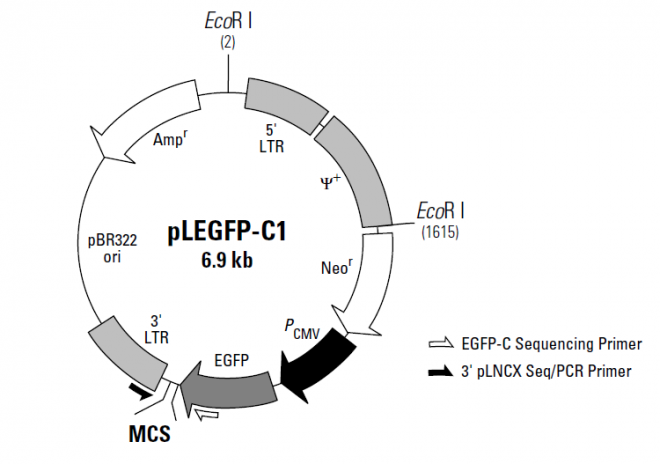
|
品牌 |
酶研生物 | |||||||||||||||||||
货号 |
MY1137 | |||||||||||||||||||
规格 |
2ug | |||||||||||||||||||
价格 |
询价 | |||||||||||||||||||
货期 |
现货 | |||||||||||||||||||
载体说明pLEGFP-C1 facilitates retroviral delivery and expression of the enhanced green fluorescent protein (EGFP, 1–4) or carboxy-terminal fusions of EGFP to a protein of interest. The retroviral elements in pLEGFP-C1 are derived from a Moloney murine leukemia virus (MoMuLV; 5–8). EGFP is a red-shifted variant of wild-type green fluorescent protein (GFP) of the jellyfish Aequorea victoria. EGFP has been optimized for brighter fluorescence and higher expression in mammalian cells. (Excitation maximum = 488 nm; emission maximum = 507 nm.) EGFP includes the GFPmut1 variant (1) which contains the double-amino-acid substitution of Phe-64 to Leu and Ser-65 to Thr. The coding sequence of the EGFP gene contains more than 190 silent base changes which correspond to human codon-usage preferences (2). Upstream sequences flanking EGFP have been converted to a Kozak consensus translation initiation site (3) to further increase the translation efficiency in eukaryotic cells. Upon transfection into a packaging cell line, pLEGFP-C1 can transiently express, or integrate and stably express, a transcript containing Ψ+ (the extended viral packaging signal), the neomycin selectable marker, and either EGFP or a fusion of EGFP to a gene of interest cloned into the multiple cloning site downstream of the EGFP gene. The 5' viral LTR in this vector contains a viral promoter that controls expression of the neomycin resistance (Neor) gene for antibiotic selection in eukaryotic cells. EGFP or an EGFP fusion is expressed from the human cytomegalovirus (CMV) immediate early promoter (PCMV). pLEGFP-C1 also includes the pBR322 origin of replication and E. coli Ampr gene for propagation and antibiotic selection in bacteria. 载体应用pLEGFP-C1 or derivatives espressing EGFP fusions to your gene of interest can be transfected into any of BD Biosciences Clontech packaging cell lines (see www.bdbiosciences.com for a complete list). pLEGFP-C1 transcripts produced in the packaging cell contain the Ψ+ (psi) RNA packaging signal, the neomycin gene, transcription and processing elements, and the gene of interest. pLEGFP-C1 does not contain the structural gag, pol, and envgenes necessary for retroviral particle formation and replication; however, these genes are stably integrated in the packaging cell genome. Once in the cell, RNA from the vector is packaged into high-titer, infectious, replication-incompetent retroviral particles (9–12). That is, these retroviral particles can infect target cells and transmit the EGFP or EGFPfusion gene, but cannot replicate within these cells since the cells lack the viral structural genes. The separate introduction and integration of the structural genes into the packaging cell line minimizes the chances of producing replication-competent virus due to recombination events during cell proliferation.
|
|
|||||||||||||||||||










